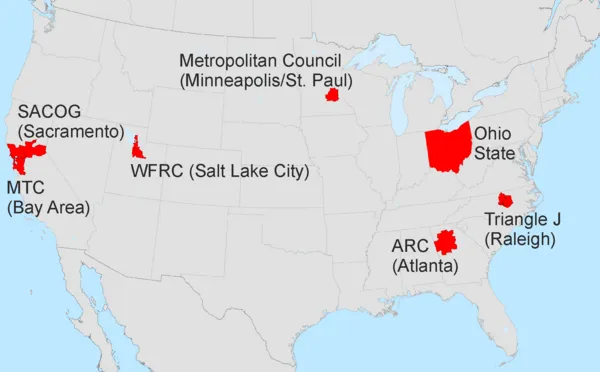Integrated Transportation and Land Use Models
The interest in land use modeling appeared to be on the rise again in 2017. New legislation being adopted in California (SB 375, 2008) and Oregon (SB 1059, 2010) had created momentum for improved land-use/transport integration. Agencies recognized that they cannot sufficiently test policies under congested conditions or in tight housing markets with transportation models alone. New transportation infrastructure changes accessibilities, which may change preferred housing locations, thereby indirectly changing origins and destinations of travel. A well-intended new highway project may fill up quickly because of new subdivisions being built near that highway. Therefore, the U.S. National Cooperative Highway Research Program (NCHRP) requested research on the state-of-practice in integrated land use/transport modeling, which was completed by this research group.
Three different types of land use models that can be integrated with transport models were identified for this report. Sketch planning models are rule-based models and excellent tools for long-term visioning, because they tend to run faster and allow to assess the development capacity of considered land use scenarios. Such models do not attempt to model human behavior explicitly but rather develop rules of development interactions. Behavioral models, on the other hand, try to represent human behavior based on behavioral theory at the expense of (commonly) longer runtimes and larger data requirements. Such advanced models can be further categorized into two types, namely microsimulation discrete choice models and spatial input-output models. Both types use advanced theory to explain human behavior, though the approaches are rather different in model implementation. The former is based on behavioral discrete choice theory, while the latter is derived from economic theories.
In-depth interviews were conducted with seven agencies in North America who apply integrated land use/transport models. These surveys showed that many agencies operate sophisticated models that have influenced decision makers. The interviews showed that model results are treated as “an additional voice at the table.” While the final judgement continues to be made by decision makers, model results are used as additional evidence whether a proposed policy has the intended effects, and whether the magnitude of the impact warrants the effort of implementing a policy. Agencies who apply such models have reported that confidence in model results generally was increased because the land use/transport feedback cycle was represented explicitly.
The full synthesis report can be downloaded free of charge on the TRB Website.
